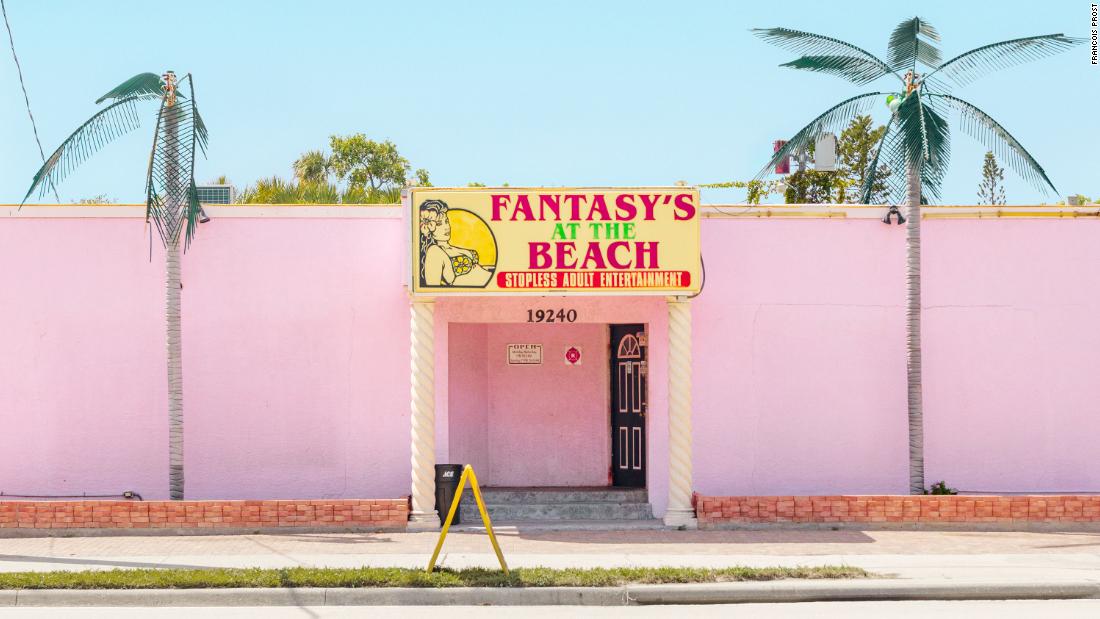
 news
news 
“I’d divide these venues into two types: One is very integrated into the public landscape, and one is a bit more hidden and dodgy,” Prost said, speaking to CNN on a video call and email.
The first type, he added, could be found in “very American” settings, such as “around amusement parks and fast food and malls.” The latter venues, however, would sometimes look indistinguishable from any store in a strip mall. Prost said he found many such establishments along the Bible Belt, a socially conservative region in the country’s south. He was especially keen to explore the area due to the apparent contrast between the prevalence of strip clubs and what he describes in his book as “conservatism and extreme puritanism.”
Prost insisted that he had little interest in the interiors or services of the strip clubs, which he always visited during the day. Instead, he hoped to learn more about American culture by creating objective, documentary-style photographs of establishments sitting at the intersection of sex, gender and commerce. Documenting changing attitudes toward sex through the lens of architecture, he added that the series was primarily of a landscape photography project.
“The prism of this theme of strip club facades became a way of studying and trying to understand the country,” he wrote in “Gentlemen’s Club,” photographs from which will feature in an exhibition in Tokyo in March.
“(‘Gentlemen’s Club’ is) an objective panorama of dominant opinions and gender and the sexualization of the feminine image.”
As he meticulously planned his trip, he was struck not only by the sheer volume of strip clubs in America but that — unlike In Europe — they often demanded to be seen. Hot pink walls, gigantic nude silhouettes and even candy-cane-striped storefronts made no secret of the kind of entertainment provided inside.
“A good example would be Las Vegas, where strip clubs are everywhere and their signs blink as much as a fast food (restaurant) or casino sign,” Prost said.
If the establishments were open during the day, Prost would enter and ask for permission to take photos in order “to not look suspicious… and explain what my intentions were,” he said. The interiors rarely lived up to the tantalizing promises plastered across the signs outside, but the photographer met a host of characters during his five-week trip, from indifferent bouncers to managers who were thrilled about the project.
“Most of the time, people were OK — 99% of them would say yes to a facade picture,” he said, adding they typically wouldn’t mind his presence, as long as he didn’t take photos of patrons or dancers.
“Some would think that it was a bit strange, some would be really excited about it and give me their business card to send me the picture when it was done,” he said.
Prost said his biggest surprise, however, was how “normalized” strip clubs appeared to be in everyday life. As he reflects in his book, “The relationship that Americans seem to have with strip clubs is quite different to what you see in Europe. Going to a strip club seems to be a lot more normalized … You go as a couple, or amongst friends at night to have fun.”
He was struck, for instance, by the fact that so many Las Vegas strip clubs doubled as restaurants — with many boasting happy hour deals, buffets and special discounts for truck drivers or construction workers.
“I noticed a few strip clubs that would advertise being a strip club and steakhouse, so you could eat a big piece of meat (while) watching strippers. That is also something that seems very American to me,” he said, adding: “I heard from some people I met in Portland there are even strip clubs (that offer) vegan food.”
The facades are littered with jokes like “My sex life is like the Sahara, 2 palms, no dates” and pun-based names like Booby Trap and Bottoms Up. Prost’s documentarian approach heightens the signs’ surreal comedy. But it also doubles as a neutral lens through which viewers can make up their own minds about the objectification of women.
By honing in on the faceless dancing bodies of female silhouettes and the quintessential “girls girls girls” signs, “Gentleman’s Club” explores the commodification of women who are, in reality, completely absent in Prost’s works (an observation reflected in the book’s title, which is a phrase that crops up numerous times on signs throughout his photographs). The strip clubs he visited market women as things to be consumed, from the many food-themed names to an advertisement reading, “1,000’s of beautiful girls & three ugly ones.”
For his next project, Prost plans to visit Japan to document the nation’s love hotels, which occupy a similar role as strip clubs in some parts of the US: open secrets in a conservative society. But the photographer believes the American establishments he visited say something unique about the country — something that is less about sexuality and more about the American dream.
What his project has shown him is, he said, this: “As long as you’re successful in terms of business, (it doesn’t matter) if your activity deals with sex.”
24World Media does not take any responsibility of the information you see on this page. The content this page contains is from independent third-party content provider. If you have any concerns regarding the content, please free to write us here: contact@24worldmedia.com